The Washington Funeral Medals (For Sale!..... in 1800)
Washington Funeral Medals have always been one of my personal favorites every since I started studying early American coinage. These pieces made by Jacob Perkins in Newburyport, MA in late 1799/early 1800 are a true view into the past. Almost all are holed to be worn around the neck, and are found in gold, silver, copper and white metal. There are two major types (and some other sub-types such as the oval shells in gold) which are the URN reverse and the Skull and Crossbones reverse. All are very scarce, and since they were meant to be used, are often found in lower grade with typical surface problems.
There is a nice, short writeup on the history of these medals on the Notre Dame website. Here is the text that was found there.
Comments: Washington died on December 14, 1799. Two funeral processions were held in Boston, the first was sponsored by the Masonic Lodge on Feb. 11, 1800 while the second was a general procession on February 22, 1800. According to Baker the Newburyport diemaker Jacob Perkins produced medals for each event. The two medals have similar obverses. The reverse of the medal for the Masonic procession, Baker 165, contains a legend in four lines with a small skull and crossbones at the bottom. The reverse of the medal shown above, though to be for the general procession, displays a legend in two lines with an urn in the center. Angel Pietri has discovered the Boston Masonic Lodge still owns an urn made by Paul Revere that contains a lock of Washington's hair. Pietri examined the procession in detail, using contemporary accounts. In the diary of the Reverend William Bently, who gave the funeral sermon for the Mason's event there is a mention of Perkins, "on this occasion so well known for his excellent medals ... of our General Washington." (Pietri, pp. 15 and 17). From this and the prominence of the urn in the procession Pietri suggests both Washington medals were produced and sold at the Masonic procession.
WA Funeral Medal Urn Reverse in Silver. Ex. LaRiviere Collection
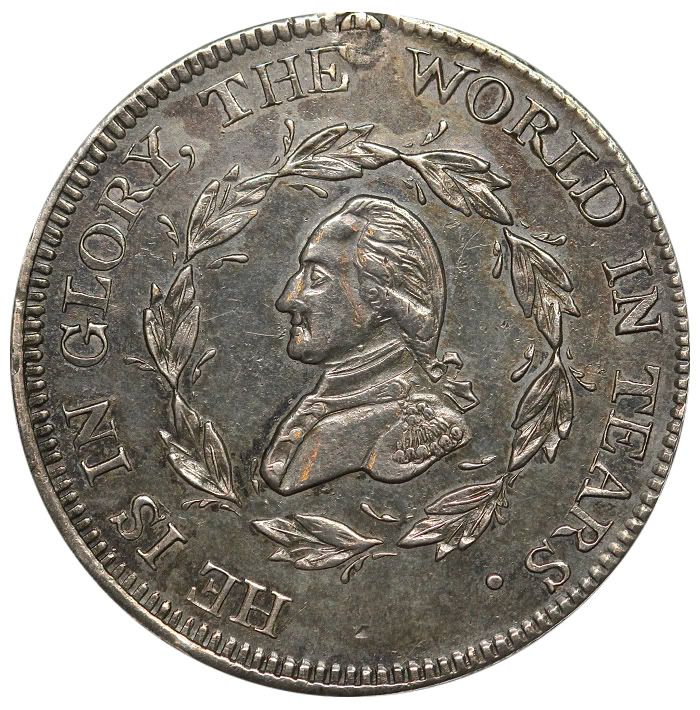
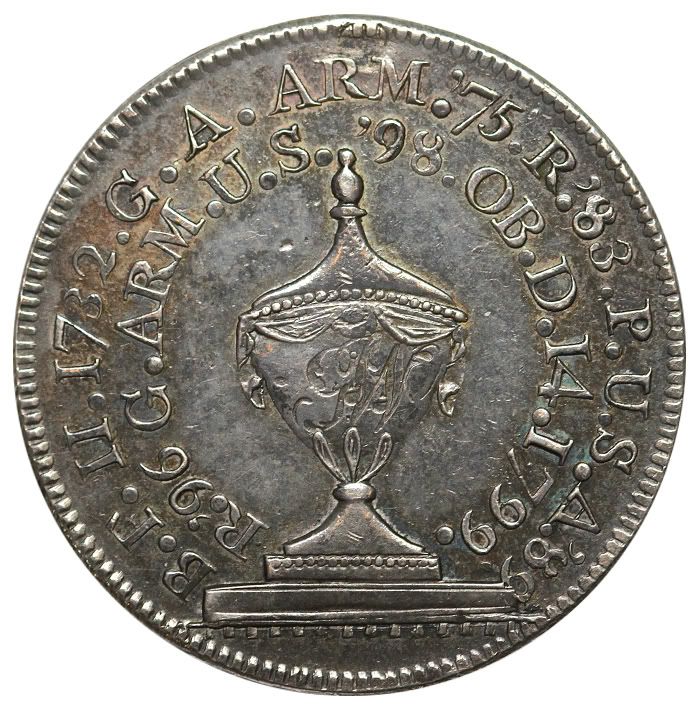
WA Funeral Medal Urn Reverse in White Metal
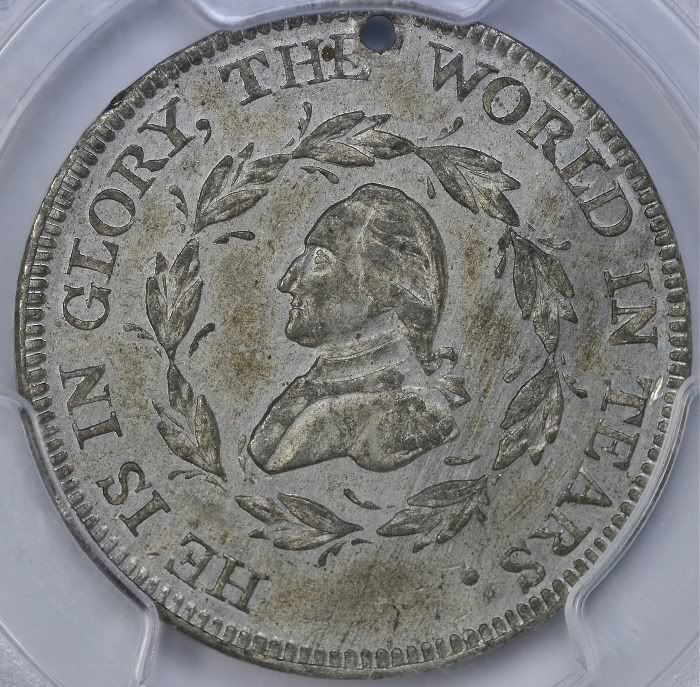
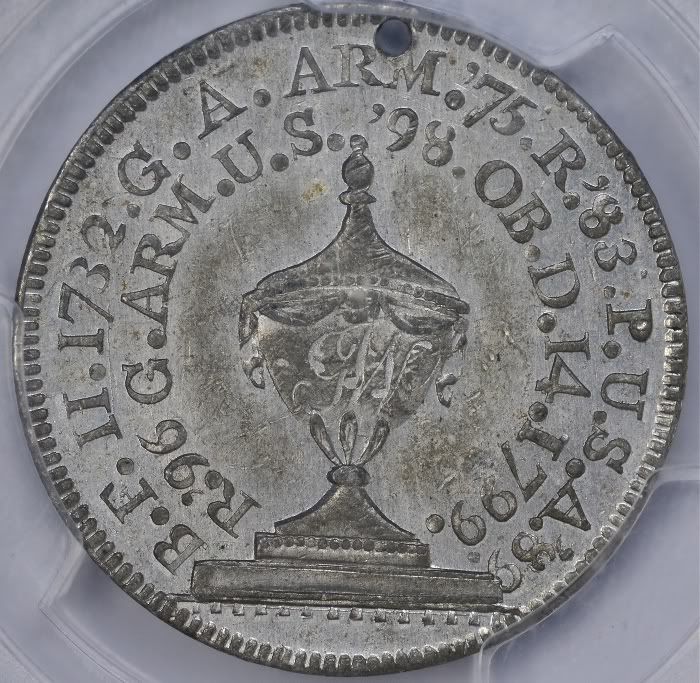
About six months ago, I stumbled across this very interesting newspaper (February 1800 Providence Journal) that includied a fantastic advertisement by David Vinton, offering Washington Funeral Medals for sale right before the two funeral processions in Boston. What struck me as very interesting when reading the ad, was the fact David Vinton was suggesting these medals were being worn in Boston, and should be purchased especially for children, so they would always remember what George Washington had done for them when they were older. I had never seen this advertisement before, and as far as I am aware, there is only one other ad known for these medals, which was done by Perkins himself to judge interest in the pieces before he even produced them.
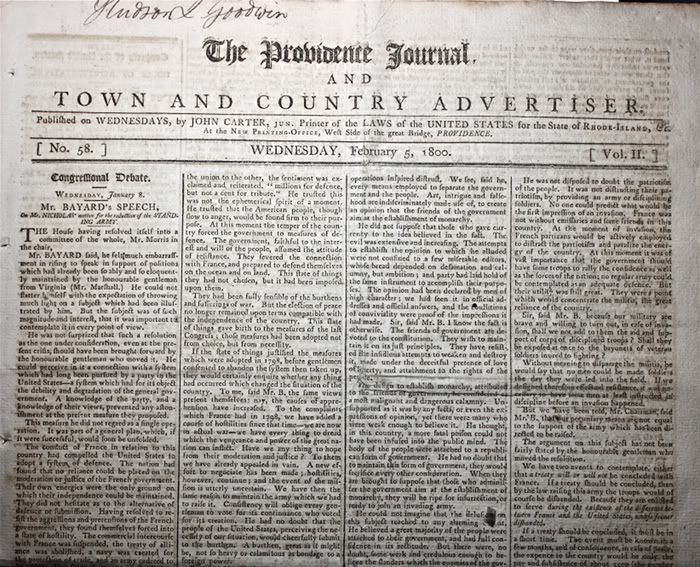
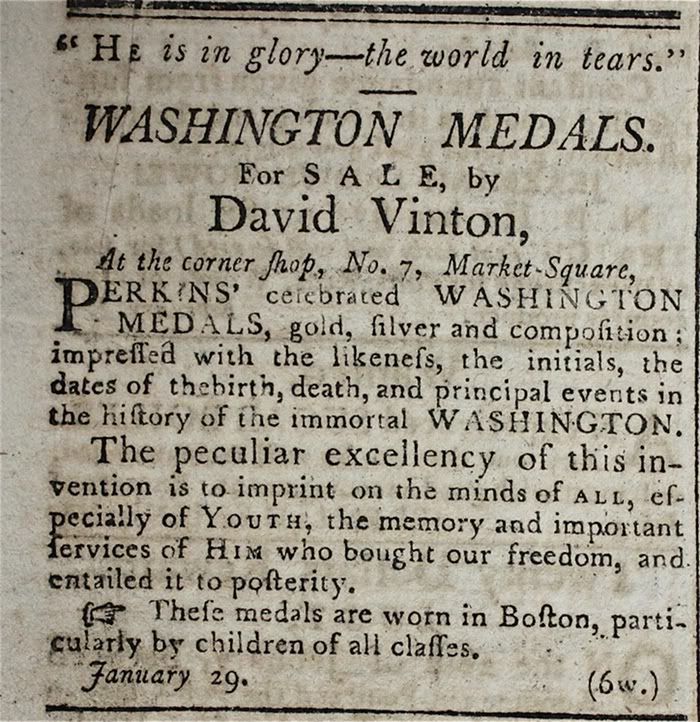
Its always fun to share information like this. Very few times do we find true windows to our past, and I figured everyone would find this pretty cool!
There is a nice, short writeup on the history of these medals on the Notre Dame website. Here is the text that was found there.
Comments: Washington died on December 14, 1799. Two funeral processions were held in Boston, the first was sponsored by the Masonic Lodge on Feb. 11, 1800 while the second was a general procession on February 22, 1800. According to Baker the Newburyport diemaker Jacob Perkins produced medals for each event. The two medals have similar obverses. The reverse of the medal for the Masonic procession, Baker 165, contains a legend in four lines with a small skull and crossbones at the bottom. The reverse of the medal shown above, though to be for the general procession, displays a legend in two lines with an urn in the center. Angel Pietri has discovered the Boston Masonic Lodge still owns an urn made by Paul Revere that contains a lock of Washington's hair. Pietri examined the procession in detail, using contemporary accounts. In the diary of the Reverend William Bently, who gave the funeral sermon for the Mason's event there is a mention of Perkins, "on this occasion so well known for his excellent medals ... of our General Washington." (Pietri, pp. 15 and 17). From this and the prominence of the urn in the procession Pietri suggests both Washington medals were produced and sold at the Masonic procession.
WA Funeral Medal Urn Reverse in Silver. Ex. LaRiviere Collection


WA Funeral Medal Urn Reverse in White Metal


About six months ago, I stumbled across this very interesting newspaper (February 1800 Providence Journal) that includied a fantastic advertisement by David Vinton, offering Washington Funeral Medals for sale right before the two funeral processions in Boston. What struck me as very interesting when reading the ad, was the fact David Vinton was suggesting these medals were being worn in Boston, and should be purchased especially for children, so they would always remember what George Washington had done for them when they were older. I had never seen this advertisement before, and as far as I am aware, there is only one other ad known for these medals, which was done by Perkins himself to judge interest in the pieces before he even produced them.


Its always fun to share information like this. Very few times do we find true windows to our past, and I figured everyone would find this pretty cool!
New England Rarities...Dealer In Colonial Coinage and Americana
0
Comments
Very cool! I'll add one to my collection one day.
We're off to the races, MLC.
RMR: 'Wer, wenn ich schriee, hörte mich denn aus der Engel Ordnungen?'
CJ: 'No one!' [Ain't no angels in the coin biz]
Very cool that the 's' got substituted for 'f' on some of the words in the paper.
Imagine if Outlook spell check had a bug like that today!
<< <i>fuper! >>
Lol
Wondering if on THURSDAY, February 6 1800 a typesetter received the first ever pink flip
<< <i>Very nice. Thanks.
Very cool that the 's' got substituted for 'f' on some of the words in the paper.
Imagine if Outlook spell check had a bug like that today! >>
Look more carefully---the letters aren't the same.
RMR: 'Wer, wenn ich schriee, hörte mich denn aus der Engel Ordnungen?'
CJ: 'No one!' [Ain't no angels in the coin biz]
Looking for Top Pop Mercury Dime Varieties & High Grade Mercury Dime Toners.
The calendar was reformed in England and its possessions in 1752.
.
CoinsAreFun Toned Silver Eagle Proof Album
.
Gallery Mint Museum, Ron Landis& Joe Rust, The beginnings of the Golden Dollar
.
More CoinsAreFun Pictorials NGC
<< <i>I'm wondering if Sonorandesertrat ever added one to his collection...
Still looking, and I have managed to repeatedly get sidetracked with other flirtations (numismatic literature, fossils, large cents).
RMR: 'Wer, wenn ich schriee, hörte mich denn aus der Engel Ordnungen?'
CJ: 'No one!' [Ain't no angels in the coin biz]
<< <i>Cool history!
Wondering if on THURSDAY, February 6 1800 a typefetter* received the first ever pink flip
*Fixed.
"Everything is on its way to somewhere. Everything." - George Malley, Phenomenon
http://www.american-legacy-coins.com
<< <i>Very cool that the 's' got substituted for 'f' on some of the words in the paper.
Imagine if Outlook spell check had a bug like that today! >>
That's not an error, of course. It's the archaic "Long s".
So the typefetter didn't get a pink flip, but the long "s" itself did, not long into the new century.
What is now proved was once only imagined. - William Blake
The old fashioned s has that line on the left only.
With a little practice, you can easily read the old printing.
<< <i>Very nice. Thanks.
Very cool that the 's' got substituted for 'f' on some of the words in the paper.
Imagine if Outlook spell check had a bug like that today! >>
That's a "long" s, which was in common use in printed text before 1800.
Now an interesting feature in the modern Greek language is that a final sigma in a word can look just like our modern "s".